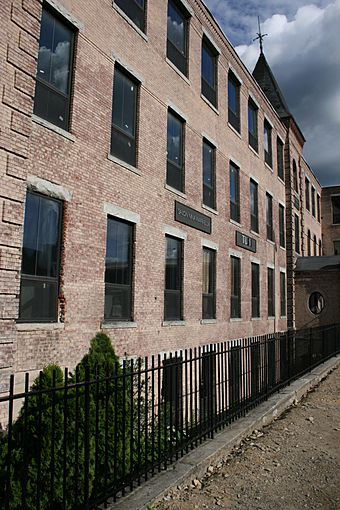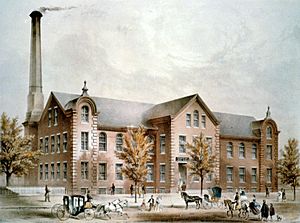Crompton Loom Works facts for kids
|
Crompton Loom Works
|
|
|
U.S. Historic district
Contributing property |
|
 |
|
| Location | 132-142 Green St., Worcester, Massachusetts |
|---|---|
| Area | less than one acre |
| Built | 1860 |
| Architectural style | Italianate |
| Part of | Blackstone Canal Historic District (ID71000030) |
| MPS | Worcester MRA |
| NRHP reference No. | 80000541 |
Quick facts for kids Significant dates |
|
| Added to NRHP | March 05, 1980 |
| Designated CP | August 15, 1995 |
The Crompton Loom Works is a very old factory building in Worcester, Massachusetts. It is located at 132-142 Green Street. This factory used to make special machines called looms. Looms are used to weave fabric.
This building is one of the oldest factories still standing in Worcester. Its first part was built way back in 1860. A man named George Crompton started the factory. His father, William Crompton, invented the first power loom that could weave fancy fabrics.
George Crompton's business grew very big. It became one of the most important employers in the city. His new looms changed the textile industry forever. The Crompton family kept making looms at this factory until the 1960s. Later, the factory also made machines for packaging cans and setting up bowling pins. Today, the building is used for other things. It was added to the National Register of Historic Places in 1980.
What is the Crompton Loom Works?
The Crompton Loom Works is a group of connected brick buildings. They are located just south of downtown Worcester, where Green and Harrison Streets meet. The buildings are between one and three stories tall.
The Building's Style
The factory buildings have a style called "industrial Italianate." This means they have special decorative corners, called quoins. They also have fancy brickwork under the roof, called corbelling. Most of the windows are rectangular. But some older parts of the building have windows with round tops, like arches.
When the main building was first built, it only had two stories. It was changed several times over the years. For example, the tall tower and the third floor were added in the 1880s.




